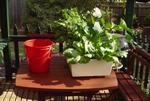Simple Manual Hydroponic Systems
 Hydroponics doesn't have to be large, complex or expensive for the beginner, or home hobbyist. Here are some ideas for simple systems that can be set up in any home garden, even on a small verandah, bacony, or in a sub room inside your house.
Hydroponics doesn't have to be large, complex or expensive for the beginner, or home hobbyist. Here are some ideas for simple systems that can be set up in any home garden, even on a small verandah, bacony, or in a sub room inside your house.
SELF WATERING POTS
Materials required:
- 1 plastic bucket or plastic ice cream container
- 1 unglazed terra cotta (clay) pot
- Coarse granitic sand/aquarium sand
- Vermiculite or peat moss
- Lettuce seedlings (2)
- 1 pkt of hydroponic nutrient
Procedure:
- Mix 60% sand with 40% vermiculite or peat.
- Fill clay pot to within 3cm or so of the lip.
- Wash as much soil as possible off the roots of lettuces (without harming the roots).
- Plant the lettuces in the pot.
- Mix up the hydroponic nutrient solution.
- Roughly measure the depth of the medium (ie. sand & vermiculite) in the pot.
- Place the pot with the lettuces in the bucket or ice cream container.
- Add nutrient until it reaches a level about one third the depth of the medium (as calculated in Step 6). The nutrient is soaked up into the medium from below. This is called capillary action.
- Top up the nutrient solution as often as is necessary to keep the level between 1/4 and 1/3 the depth of the medium.
HANGING GARDENS
- Any sort of waterproof bag can be used for hydroponics, as long as it is strong enough to hold the media (eg. perlite, sand or rockwool) that you are using. Some garden centres sell grow bags that can be used for this job. This technique is great for growing strawberries:
- Fill the bag with a hydroponic media
- Make some small drainage holes in the bottom
- Hang up the bag, leaving an opening at the top to pour in nutrient solution
- If necessary, use a clamp to hang the bag
- Cut holes in the side and plant your plants
- Continue to apply nutrients, ensuring that the bag doesn’t dry out
BUCKET & BED SYSTEM
A box is built on the ground or a bench and lined with plastic, cement or something else to make it waterproof. The base should be sloped to drain away any excess solution. The low point should have a drainage hole that can be plugged. The bed is filled with media and plants can then be planted.
A bucket or other container holding nutrient solution is connected to a hose. The container can be raised to allow nutrient solution to flow into the bed, then lowered, to stop the flow –or even allow excess to flow back into the bucket.
DRUM & BED SYSTEM
This is a larger version of the bucket and bed system, hence it becomes difficult to raise and lower a large container filled with nutrient solution.
Excess solution can be kept in the bed for a time by keeping the drainage hole plugged. By removing the plug it can be allowed to drain away (either going into the garden or filling a pit, where it can be scooped out and used again).
Planting into Hydroponics
Plants need most of the soil removed from their roots before you plant them in hydroponics. Do this by immersing the root ball in water & squeezing gently as you wash the soil or potting mix away. Be careful not to damage roots. It is better to retain a little of the old media stuck to the roots than to damage roots and kill the plant.
What can be used as a media?
Normal potting soil will not do. Hydroponic media needs to be free of nutrients and disease. Any clean, inert material that makes a good environment for plant roots will do.
It needs to:
- Be free draining
- Be sterile -100% clean
- Be able to retain moisture
- Be free of nutrients
- Not decompose or rot down
Ideal media include horticultural rockwool, perlite and coarse washed sand.
Feeding Plants in Hydroponics
Hydroponic fertilizer is NOT the same as normal fertiliser.
It has other things in it! (ie. Calcium, magnesium and micro nutrients). You can buy specially prepared hydroponic fertilizer from specialist suppliers.
Make sure you buy fertiliser designed for hydroponics: or learn to make your own.
You may also be interested in....